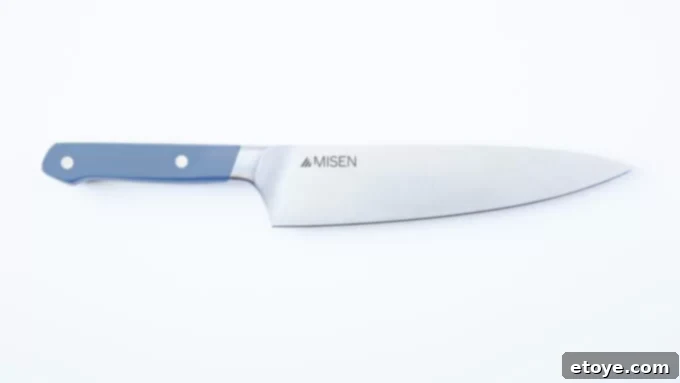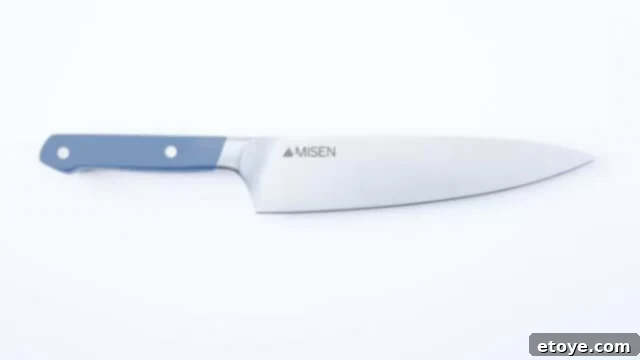
In the vast world of kitchen cutlery, Misen emerged with a clear and ambitious goal: to craft an exceptional, high-quality chef’s knife that is both affordable and accessible directly to consumers. This comprehensive Misen Knife review delves deep into the performance, design, and overall value of their flagship product, highlighting its strengths and weaknesses to help you make an informed decision for your culinary needs.
Misen Chef’s Knife Review: The Everyman’s Culinary Workhorse?
Misen’s journey began on Kickstarter, where their innovative concept resonated with over $1 million in funding. The vision was simple yet profound: to create a beautifully designed, durable chef’s knife made from quality steel, capable of rivaling premium models costing upwards of $200, all while maintaining an accessible price point of just $65. This ambitious promise sparked significant interest among home cooks and professional chefs alike. But did Misen truly succeed in delivering this “Everyman’s workhorse knife”? Let’s find out.
Misen Knife PROs: Unpacking Its Strengths
Hybrid Design: The Best of Both Worlds
The Misen chef’s knife boasts a thoughtful design that intelligently blends the characteristics of two dominant knife traditions. It incorporates the distinct European curved belly, ideal for the rock-chopping motion favored in many Western kitchens, allowing for fluid and efficient processing of ingredients. Simultaneously, it features the thinner, sharper edge commonly found in Japanese knives, known for their precision and ability to achieve exceptionally fine cuts. This fusion aims to provide a versatile tool that excels in various culinary tasks, from dicing vegetables to slicing delicate proteins.
The Heart of the Blade: Japanese AUS-8 High Carbon Steel
The Misen knife is crafted from Japanese AUS-8 High Carbon Steel, a material chosen for its balanced properties. This particular alloy includes vanadium, an element that significantly enhances wear resistance and contributes to the steel’s toughness, making the blade robust enough for daily use. Furthermore, vanadium is reputed to make the steel easier to sharpen, a crucial benefit for maintaining peak performance. While not considered a “super steel” in the same league as some ultra-premium alloys, AUS-8 strikes an excellent balance between several key attributes: durability, ease of sharpening, and resistance to rust. It’s a reliable, mid-grade material widely employed in many reputable Japanese kitchen knives, providing consistent performance without the fragility or high maintenance demands of harder, more exotic steels.
Graphic from Misen:

Optimal Hardness: The 58º-59º Rockwell Sweet Spot
A knife’s hardness, measured on the Rockwell scale, is a critical factor influencing its performance. Misen tempers its blade to an ideal 58º-59º Rockwell. To understand this, higher Rockwell numbers generally indicate harder steel, which means better edge retention (the ability to stay sharp for longer) but also increased brittleness. Conversely, softer steels require more frequent sharpening but are less prone to chipping. My personal collection includes high-end Japanese chef’s knives with a hardness of 60º-61º Rockwell, which excel at precision but are more susceptible to chipping if dropped or used for heavy-duty tasks like cutting through bones. This higher hardness often makes them more challenging and time-consuming to sharpen.
The Misen’s 58º-59º Rockwell rating represents a “sweet spot” for the average user. It’s hard enough to maintain a sharp edge through extensive use, reducing the frequency of sharpening, yet resilient enough to withstand the rigors of a busy kitchen without becoming overly brittle. This balance ensures a durable and dependable knife that is neither excessively prone to dulling nor prone to catastrophic damage from accidental impacts.
Impressive Edge Retention: Staying Sharp When It Counts
After two weeks of consistent, heavy daily use—including extensive recipe testing and preparing numerous family meals without any honing or sharpening—I put the Misen knife through a demanding test. It tackled two pounds of potatoes, three pounds of carrots, and two heads of cabbage for a large batch of vegetable soup. Following this, it was used to thinly slice six pounds of London Broil for beef jerky, a task I typically reserve for an electric meat slicer due to its intensity. This extensive workload provided a true measure of its edge retention.
To assess its sharpness post-workout, I performed the classic “tomato drop” test. Initially, the tomato bounced off the blade twice, indicating that the edge, while still functional, had lost some of its initial razor-sharpness. However, a few quick swipes on a honing steel quickly revitalized the edge. On the third attempt, after just a few seconds of honing, the tomato sliced effortlessly through the blade – a magical transformation. This demonstrated that while the Misen knife required some maintenance after heavy use, its edge was easily restored through simple honing, passing the real-world test for daily kitchen demands. The ultimate benchmark for any knife is how long it can go without needing a full sharpening, and the Misen excelled in maintaining a usable edge with minimal effort.
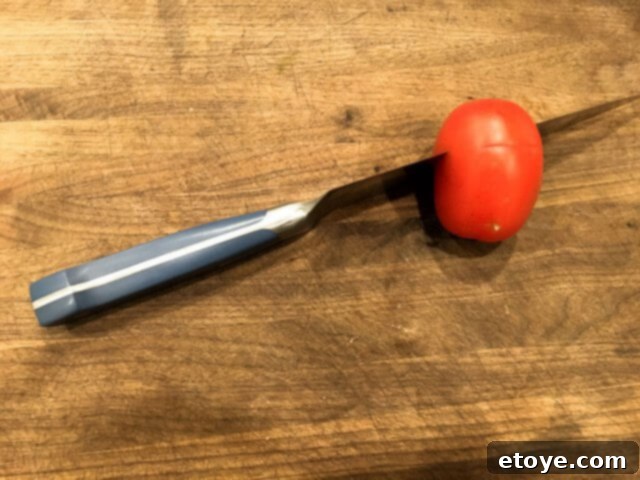
Honing is a quick and straightforward process, taking no more than ten seconds to realign the blade’s edge. Sharpening, on the other hand, is a more involved activity. I typically sharpen all my knives quarterly, using either the Chef’s Choice Angle Select electric sharpener (highly recommended for its versatility with both Asian and European style blades) or dedicating a focused hour and a half with my Japanese Naniwa water stones for a meditative and precise edge. It’s worth noting that while my colleague, J. Kenji López Alt at Serious Eats, shares my admiration for the Misen, Joe Ray at Wired reported a somewhat different experience, highlighting the varied perceptions of knife performance.
Unparalleled Comfort and Ergonomics
Among my extensive collection of knives (I confess to owning three fully stocked knife rolls), the Misen stands out as the most comfortable for prolonged, heavy-duty cutting tasks. Several design elements contribute to this superior ergonomic feel:
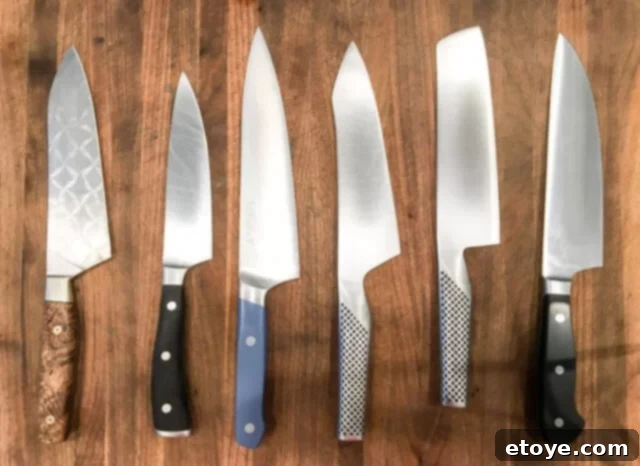
Balanced Weight for Effortless Cutting
Weighing in at 7.9 ounces, the Misen offers a substantial feel without being cumbersome. This weight provides a significant advantage when tackling dense, fibrous vegetables, tough cuts of meat, or potatoes. Heavier knives leverage gravity and momentum, reducing the physical effort required from the user. In contrast, lighter knives, such as the Japanese Global series (5.8 and 6.2 ounces), are excellent for delicate, precise work like creating paper-thin slices of onion or bell peppers for stir-fries. However, they demand more user effort when cutting through thick roasts or hard squash. For comparison, the Wüsthof Uber Cook’s Knife, another excellent performer, weighs a very similar 7.5 ounces, reinforcing the Misen’s optimal weight class.
The Revolutionary Sloped Half-Bolster
The bolster, the thickened part of the knife that transitions from the handle to the blade, is a critical ergonomic feature. Many knives feature a full bolster, which can hinder sharpening the entire blade and sometimes cause discomfort with a pinch grip. My custom-made New West Knifeworks knife, for instance, has a thick, horizontal bolster with a hard edge that can lead to callouses. Conversely, knives like the Global series have no bolster, offering excellent control for a pinch grip but lacking the protective barrier. The Misen’s sloped half-bolster is a game-changer. Its gentle curve allows my forefinger to hook perfectly into the groove, with my thumb naturally falling into place. This graduated design provides an enhanced pinch grip, translating to superior control and comfort compared to any other knife I own. It truly makes a difference during extended prep sessions.
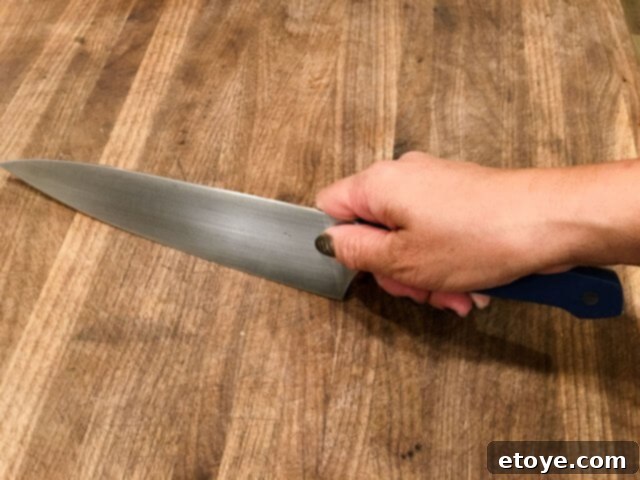
The half-bolster design also offers a significant practical advantage: it allows the user to utilize and sharpen the entire length of the blade. This is a common issue with full-bolster knives, where the bolster can prevent proper sharpening of the heel, leading to an unused portion of the blade over time. For example, a knife with a full bolster, while offering some protection, is generally not recommended for optimal long-term usability and sharpening.
Precision with an Asian-Style 15º Edge
Misen incorporates a precise 15º edge, which is typically found in Asian-style knives. This sharper angle offers superior cutting performance and allows for more precise, delicate slices compared to the broader 20º edge common in many European knives. While a 20º edge can be beneficial for heavy-duty tasks like butchering chicken and whacking through bones (a task I reserve for my formidable Chinese cleaver), the 15º edge is perfectly suited for the vast majority of daily kitchen tasks, providing effortless slicing and chopping.
Graphic from Chef’s Choice, experts in electric knife sharpening:
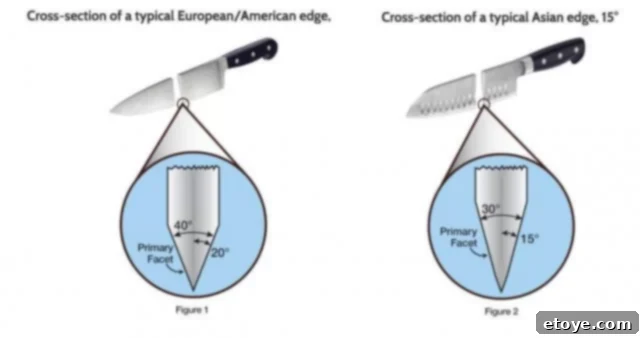
The Value-Add: Free Lifetime Sharpening
For those who find sharpening a chore, Misen offers an attractive incentive: free lifetime sharpening. While I personally enjoy the meditative process of sharpening with Japanese water stones when time allows, and electric sharpeners offer a quick (albeit noisy) alternative, the lifetime sharpening service presents a significant long-term value. Instead of investing $150 in a high-quality electric sharpener or paying $8-$10 per knife for local sharpening services, you have the option to ship your Misen knife back for complimentary professional sharpening. This feature can be a compelling factor for many, eliminating a common barrier to maintaining a sharp and effective kitchen tool.
Misen Knife CONs: Areas for Improvement
Manufacturing Origin: Made in China
While the Misen knife benefits from Japanese AUS-8 steel, its manufacturing takes place in China. For some consumers, the country of origin can be a point of concern regarding quality perception or ethical considerations. However, it’s important to recognize that many high-quality products are manufactured in China, and Misen’s direct-to-consumer model and competitive pricing are certainly influenced by its manufacturing strategy. This trade-off allows them to offer a premium product at an accessible price, but it’s a detail worth noting for those who prioritize specific manufacturing locations.
Price Point in a Competitive Market: Is $65 Truly “Cheap”?
Misen set out to create an affordable, quality knife, and at $65, it undeniably offers excellent value. However, the kitchen knife market is highly competitive, with a growing number of brands offering compelling options. For instance, the Shun Sora 8-inch knife, crafted in Seki, Japan, is priced only $15 more than the Misen. While the Misen provides impressive performance, the Shun Sora uses a different, often perceived as higher quality, steel. Knives of this caliber, including both Misen and Shun, are built to last for many years with proper care (my Global knives are still going strong after nine years). For a slight increase in initial investment, some consumers might opt for a knife from a brand with a longer heritage of premium materials and manufacturing.
That said, the Misen’s free lifetime sharpening service helps to offset its price in the long run. When considering the recurring costs of maintaining a sharp edge—either through purchasing an expensive electric sharpener, paying for local services, or the shipping costs associated with sending it back to Misen—the cumulative savings from this service can make the initial $65 investment even more attractive, particularly for those who prefer professional sharpening.
Transparency and Company Information: A Minor Hurdle
One notable concern with Misen is the relative lack of transparency regarding its company details. Their official website, misen.co, remains quite sparse, offering minimal information about the founders, company location, or a comprehensive “About Us” section. Even the FAQ page provides only a brief, generic paragraph about their ethos. While the Kickstarter page offers slightly more context, founder names are limited to first names only. This lack of detailed corporate information can create hesitation for consumers who value full transparency and want to understand the team and structure behind the brand they are supporting. Furthermore, the mechanics of their lifetime sharpening service, specifically how it will function logistically in the long term, are marked as “TBD” on their website, adding to the uncertainty. I hope Misen will flesh out these details as they grow, as trust and clarity are paramount for direct-to-consumer brands.
In Conclusion: A Workhorse with Heart
The Misen Chef’s Knife firmly establishes itself as a highly comfortable and effective tool, particularly for demanding tasks involving significant chopping. Its hybrid design, combining European curves with a sharp Asian-style edge, provides versatility, while the Japanese AUS-8 steel and optimal Rockwell hardness contribute to impressive edge retention and durability. The ergonomic sloped half-bolster is a standout feature, offering unparalleled comfort and control during extended use. It’s a genuinely attractive knife, and I especially appreciate its distinctive cornflower blue accent.
While the free lifetime sharpening is an appealing offer, the cost and logistics of shipping might prompt some users to opt for local sharpening services instead. The main area for Misen to improve upon is company transparency, providing more comprehensive information about their team and the operational details of their long-term services. Despite these minor reservations, the Misen chef’s knife delivers on its promise of an affordable, high-quality, and exceptionally comfortable kitchen companion. It’s a strong contender for home cooks seeking a reliable and ergonomic blade that punches above its weight class.
Misen Knife Giveaway
Misen is providing a knife for a lucky winner!
